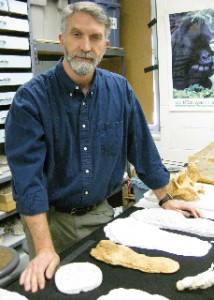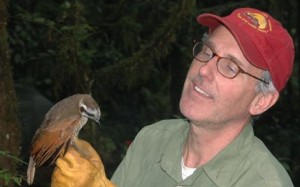Cryptozoology Enhances Zoology
Posted by: Loren Coleman on January 25th, 2010
Her article states, in part:
The story of the growling bird goes back to the mid-1890s when a shipment of stuffed birds, intended to adorn women’s hats, arrived in Europe from New Guinea.Included was a mysterious ‘new’ bird with six wires emerging from its head, subsequently named Berlepsch’s Six-Wired Bird of Paradise. No one knew where it came from, although numerous attempts were made to discover its origin over the next century. But until Beehler’s 2005 trip, no one could even say if the bird still existed.Not that the Bird of Paradise was the only surprise. The same area yielded a previously undescribed giant rat, weighing 3lbs, and a tiny pygmy possum. ‘It was as cute as a button,’ says Beehler, who works for Conservation International.Perhaps most exciting of all for Beehler, who describes himself as primarily a ‘bird man’, was the discovery of a new species of honeyeater, which has since been named the Wattled Smoky Honeyeater (Melipotes carolae) – carolae after Beehler’s wife Carol.This is the stuff that zoologists dream of: discovering a brand new species, verified by science and officially named. Or tracking down a species thought to be extinct. Or, perhaps best of all, obtaining definitive proof of a legendary animal. The latter is more the realm of the cryptozoologist (a category that includes people who search for mythical animals such as the Loch Ness Monster or Bigfoot).‘The lost Bird of Paradise was clearly in the realm of cryptozoology,’ says Beehler. ‘Crypto means, literally, hidden.’ Indeed, although it sometimes seems as if every rock has been overturned and every wilderness explored, the extraordinary fact remains: after all the human investigation, destruction and exploitation of animal life on Earth, there are hundreds of thousands of species still to be discovered.‘There could be up to 100 million species still to be described,’ Beehler says. ‘We’ve only described around 1.5 million so far.’

The Laotian rock rat. Photo: Florida State University.
Recently, it appears, the discoveries are coming thick and fast. In November 2008, anthropologists spotted a pygmy tarsier in Indonesia, a gremlin-like creature not seen since 1921.And last year nearly 6,000 Irrawaddy dolphins, thought to be on the verge of extinction, were seen in Bangladeshi waters. The dolphins, which are related to killer whales, have large rounded heads and gormless grins.Other recent discoveries include the Laotian rock rat, a rodent with a football-shaped head, and the Saola, a cross between a deer and a cow, found in Vietnam.***…the differences between species are minuscule, as Raoul Bain, a herpetologist at New York’s American Museum of Natural History, explains to me amid his jars of preserved frogs.‘It is quite literally a game of “spot-the-difference” sometimes,’ says Bain, who does most of his field work in Vietnam. ‘It can come down to different colouration on the back of the thigh, or maybe the pattern of spines.’Once you do find something it is a race to get it officially recognised. ‘One time I discovered at least three species that were new but they were all published by other people within a month of me returning from the field. That’s the game,’ Bain says.One of the reasons that discoveries are multiplying is that the methods for analysing species are now more sophisticated. ‘The advent of molecular techniques has helped a lot,’ Bain says. ‘I recently discovered a new species of large frog; I was informed by the molecular data.’Still, most scientists say that you cannot replace good old-fashioned boot leather: it is only by tramping to every nook and cranny on Earth that you are going to find anything new.As I talk to more and more experts in each area, I realise how passionate, even obsessed, they are about the creatures they study.‘Possums are my passion,’ says Rob Voss, a mammalogist. ‘Most of us tend to be what Dr Johnson called “harmless drudges”. If someone came in tomorrow and plonked a brand new possum on my desk, it might take me five minutes to figure out that it’s new.‘But that’s because that is all I think about. I want to know exactly how many species of possum there are. We currently recognise about 95 species but I would guess there are about 150.’He has two species named after him by colleagues. ‘One is a fossil mouse and the other…,’ he starts chuckling, ‘is an intestinal parasite: I think it was meant well but there is a history of naming repulsive organisms after one’s enemies!’Later, I spend an afternoon with Ian Harrison, an ichthyologist (fish expert) who divides his time between Conservation International and the American Museum of Natural History. We meet at the museum, where he enthuses about catfish that walk on their fins and gobis that wander around mangroves.‘Gobis are incredibly cute, beautiful fish with eyes on top of their heads and wonderful little characters,’ he says. It strikes me that I had never really thought about a fish’s character before. ‘Some fish are really, really nice,’ Harrison says.His favourite fish is one he has yet to see alive. Harrison opens a jar on his desk and pulls out an extraordinarily ugly fish encased in blubbery rolls of flesh.The specimen is nearly a century old and drips all over the papers on his desk. Harrison does not seem to notice – or care. It is, he tells me, a Rhizosomicthys totae, otherwise known as the fat catfish, now classified as extinct.Harrison, who grew up in Tunbridge Wells, is convinced the fish still exists and has invested a considerable chunk of his life searching for it, even travelling with a team to Lake Tota in Colombia to try to find it – but the mission was cut short when they caught wind of a possible kidnap attempt by a left-wing rebel group in the area.‘We decided that it wasn’t worth getting kidnapped for,’ he says, giving the impression that it was a hairline decision. ‘But I would love to go back there one day.’I ask him what he thinks about quests for creatures like the Loch Ness Monster – the existence of which British naturalist Peter Scott tried hard to prove in the Seventies.‘I have to say I wouldn’t invest a lot of time looking for a Loch Ness Monster,’ he chuckles. ‘On the other hand, what made Peter Scott’s work interesting is that he set up a kind of rationale for doing what he was doing. That is what defines a quest. You are going out to answer a particular set of questions you have in your mind.’
‘Another way to find a new species,’ says Jeff Meldrum, Idaho State University’s associate professor of anatomy and anthropology, ‘is to walk into a village in some far-flung place and look at what the kids have tied up on a leash somewhere or to examine the pelt that’s nailed to the side of a hut. Or to look on the dinner plate and see what’s there.’Indeed, many so-called ‘new’ species are already known to locals, particularly in more primitive areas. But no animal officially ‘exists’ until a scientist says it does.It’s no use returning from a stroll through the jungle and saying you have seen a huge black jaguar twice the size of other jaguars – as a Catholic missionary working in Amazonian Peru did recently – unless you have some physical evidence.Meldrum is an eminent professor and a cryptozoologist. As a specialist in the evolution of bipedal primates, he devotes every spare minute to his hunt for none other than Bigfoot (known in different locations as the Sasquatch, Yeren or yeti).‘The only shred of doubt for me is the persistently missing definitive physical proof.’Nevertheless, he has a laboratory containing 200 casts of footprints made, he says, by a large bipedal primate: ‘I am convinced, based on a thorough analysis of those tracks, that we are dealing with the footprints of an unrecognised primate.’Certain that they live mostly in the forests of the Pacific Northwest, he believes that the reason there has been no definitive sighting is that they are naturally reclusive.
‘It took Jane Goodall months before she got her first glimpse of chimpanzees. And she was looking for a group of gregarious boisterous primates on the single side of a little mountain valley. It just shows the ability of these animals to avoid human observation,’ Meldrum says.In one remote location where he was trying to track the Sasquatch he experienced something so strange one still windless night that he is convinced that only a large primate could be responsible.‘We had gone to a location only accessible by float plane – 100 miles from anywhere in any direction – and late one night, one of the guys was relieving himself off the porch and while he was standing there this stone comes whizzing past him and hits the metal siding of the cabin.‘It was thrown with some force so it really pinged off the cabin wall. I came out of the cabin and one of the fellows said: “Why don’t we throw something into the woods and see what happens?” So we tossed a stone in there and about five minutes went by and out comes another stone that was even bigger and bounced across the metal corrugated roof.‘We went into the woods with thermal imaging equipment and night vision binoculars. But whatever it was had vanished.’He also cites evidence from a Chinese park ranger, who apparently saw the Yeren.‘He was on patrol and across the small canyon on the opposite flank of the valley sunning itself on a large boulder was a big reddish brown figure. He yelled at it to get its attention – it sat up and spied him and then slid off the rock and walked away on two legs.‘Later he came across tracks at a watering hole and cast a right and a left foot. I met him and I was stunned – the tracks showed a very distinctive mid-tarsal pressure ridge that was identical to the tracks I’ve examined that are attributed to the Sasquatch.‘He didn’t have any concept or knowledge of Bigfoot or Sasquatch at all. So the notion that this is some copycat stunt is out of the question.’Recently, too, there was the discovery of ‘The Hobbit’, a dwarf-like species in the genus Homo, which is thought to have lived until relatively recently (18,000 years ago, which is recent in scientific terms).
The unearthing of bones in Flores, Indonesia, which verified the myth of a tiny man, was so surprising that Henry Gee, editor of the revered Nature journal wrote: ‘The discovery that Homo floresiensis survived until so very recently, in geological terms, makes it more likely that the stories of other mythical humanlike creatures such as yetis are founded on grains of truth.’Goodall herself has backed Meldrum’s theories about the Sasquatch. ‘You’ll be amazed when I tell you that I’m sure that they exist,’ she said recently.On the whole, cryptozoologists are less interested in the smaller species. ‘Most of them are into the big animals,’ says Voss, the mammalogist.‘There’s a high learning curve to figuring out the small stuff. And in my opinion we have already got 99 per cent of the mammals bigger than a breadbox.’Bruce Beehler agrees: ‘It’s mainly insects: beetles – lots and lots of beetles – and plants left to be found. Having said that, there are new primates that have been found in Brazil, new lemurs from Madagascar, at least one new wallaby from the Foja Mountains…’As he reels off more discoveries, I ask Beehler what exactly the point of all this is?‘That’s a good question,’ he replies amiably. ‘For the average person, the description of a new weevil is probably not that significant. But we actually look at the species of the world as the building blocks of Earth. It’s a library of knowledge.’It’s also a way of conserving threatened areas. ‘That weevil lives in a habitat that is beautiful, that produces water to drink, that produces a million other cool things, it’s not only the weevil that is important.’Beehler’s discovery of the Bird of Paradise in the Foja Mountains has added substantial grist to the argument for preserving the area as a wildlife sanctuary.The sea, however – through sheer expanse and impenetrable depth – probably holds larger secrets than the land. In 1976, the megamouth shark was discovered – a creature with distinctive rubbery lips and a rounded snout that can weigh up to 1.2 tonnes.‘That,’ as Ian Harrison says, ‘is a substantial-sized animal that’s been cruising around undetected.’***
About Loren Coleman
Loren Coleman is one of the world’s leading cryptozoologists, some say “the” leading living cryptozoologist. Certainly, he is acknowledged as the current living American researcher and writer who has most popularized cryptozoology in the late 20th and early 21st centuries.
Starting his fieldwork and investigations in 1960, after traveling and trekking extensively in pursuit of cryptozoological mysteries, Coleman began writing to share his experiences in 1969. An honorary member of Ivan T. Sanderson’s Society for the Investigation of the Unexplained in the 1970s, Coleman has been bestowed with similar honorary memberships of the North Idaho College Cryptozoology Club in 1983, and in subsequent years, that of the British Columbia Scientific Cryptozoology Club, CryptoSafari International, and other international organizations. He was also a Life Member and Benefactor of the International Society of Cryptozoology (now-defunct).
Loren Coleman’s daily blog, as a member of the Cryptomundo Team, served as an ongoing avenue of communication for the ever-growing body of cryptozoo news from 2005 through 2013. He returned as an infrequent contributor beginning Halloween week of 2015.
Coleman is the founder in 2003, and current director of the International Cryptozoology Museum in Portland, Maine.















Great article. Kudos to the article writer.
It is a good article, and kudos to the writer for making the point that it’s not just small creatures being discovered. Odd that she missed van Roosmalen’s tapir, though, as I believe that’s the largest land animal by mass to be described since the Vu Quang ox. And the description of the saola as “a cross between a deer and a cow” needs work. It’s hardly a cross of any sort, and even if she just meant it looked like one – well, it doesn’t.
Still a good article, though.